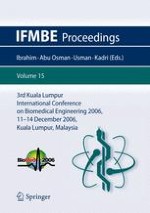2007 | Buch
3rd Kuala Lumpur International Conference on Biomedical Engineering 2006
Biomed 2006, 11 – 14 December 2006 Kuala Lumpur, Malaysia
herausgegeben von: Fatimah Ibrahim, Noor Azuan Abu Osman, Juliana Usman, Nahrizul Adib Kadri
Verlag: Springer Berlin Heidelberg
Buchreihe : IFMBE Proceedings
